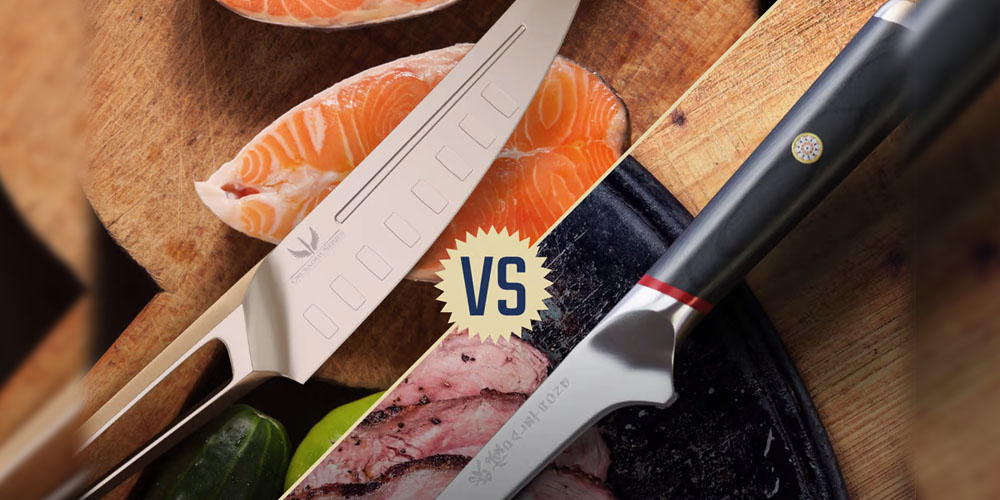Caesar is a hard-working individual who excels in business. He has been working in the same company for many years and has climbed the ranks to become one of the top employees. Caesar is dedicated to his work and takes great pride in providing value to his team and customers. He is an excellent problem solver and always looks for ways to improve efficiency and productivity. When he's not working, Howard enjoys spending time with his family and friends. He loves being active outdoors, playing sports, and exploring new places.

A good fillet knife has been a unique form of boning knife noted because of its flexibility as well as a specialty in the preparation of fish. A boning knife has been a useful item of utensil for culinary uses. Although the similarities in both of these knives’ designs, uses, and flexibility, there are several differences in them as well. So, the controversy about whether to use a boning or filet knife is genuine, and here you are going to uncover the facts.
1. The Distinction Between Basic Characteristics
The flexibility of a quality fillet knife has been its main feature. It’s particularly noted for its exceptional thinness. Fillet knife is really incredible. They’re ideal for even the hardest cuts of meat. The blade of the fillet knife differs in length. As a result, different varieties of such knives are appropriate for various fish sizes.
The boning knife does have a blade that is narrower than that of most of the blades you’ve noticed or utilized in the kitchen. Its blades, although, are thicker as compared to fillet knives. Whenever it concerns flexibility, such knives could be flexible; however, they aren’t always.
2. The Material Differences
The choice of materials is among the primary commonalities between boning and fillet knives. Boning and fillet knives are made from two main materials. These are:
- Carbon steel
- Stainless steel
Most of the boning and fillet knives have been produced from carbon steel because you want a sharp blade to remove bones from flesh and skin without harming the flesh. It has a sharper edge as compared to stainless steel. It also helps to keep its blade-edge junction in place. Accuracy and precision are affected by these two parameters. As a result, the material has a crucial part in the fillet and boning knives’ quality.
Stainless steel is preferable because of its anti-rust Qualities. If you’re willing to spend a little extra on a fillet or boning knife, you’ll get a two-for-one deal since excellent knives are long-lasting, corrosion-free, and razor-sharp.
Carbon steel is preferable in fillet knives, according to some professionals, whereas stainless steel is somewhat preferable in boning knives. However, both knives are available in both metals.
3. The Variation in the Length of Blade
Without the information about the length of the blades, the comparison between a boning and a fillet knife is incomplete. Since the fillet knife’s blade is quite narrow, it is ideal for separating skin and bones from fish. The blade can be bent upwards at times.
Fillet knives are available with a variety of blade sizes between 4- 9 inches.
The blade of a boning knife is thicker than that of a fillet knife. Nonetheless, in comparison to many other knife blades, it is quite narrow. A boning knife mostly has a straight blade.
Another reason why we utilize fillet knives on delicate meat and the boning knife or tougher, bigger meat like pork and beef is because of this.
The length of the blade of a boning knife is normally five to six inches. The blades of the Boning knife can be as long as 9 inches.
4. The Difference Between Their Uses
The distinction in the uses of these 2 kinds of knives would round up the fillet and boning knife debate. When you are cooking delicate meat, you probably utilize a fillet knife rather than a boning knife.
You may even utilize a boning knife that is flexible and thin for some fish cutting. The fillet knife, on the other hand, would always perform a good job. As a result, you’ll often utilize these two sorts of knives individually.
A boning knife is ideal for extracting bones from the flesh, particularly “tougher” pieces. However, the fillet knife seems to be more flexible. It has the capability of extracting both skin and bones.
The fillet knife’s usefulness originates from its extraordinary thinness. As a result, inserting the knife into the meat as well as the skin is simple, specifically when it refers to fish.
Final Words
You have covered everything there is to learn about the distinctions between a boning and a fillet knife. To summarise, both knives must be in the kitchen.
